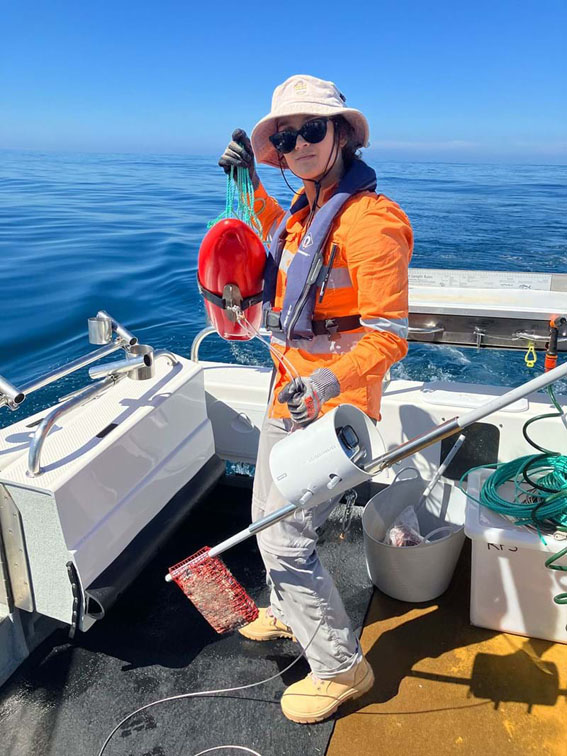RPS’ Senior Principal Scientist, Mike Mackie, explains why pelagic fish surveys are an important component in environmental impact assessments for offshore wind farm developments.
As part of the process to gain government approval to build an offshore wind farm in Australia, there are various environmental studies that need to take place.These studies inform environmental impact assessments – a measure of a development’s potential impact on habitats and species in the area.It’s both a privilege and a huge responsibility to map the marine environment as accurately as possible so developers can amend designs or undertake mitigation measures to ensure construction and operation of an offshore wind farm will have minimal impacts.So, the question every developer and regulator must decide: what marine environmental surveys are needed? And, depending on the location of future offshore wind farms, I believe, there’s a strong case for including pelagic fish surveys when assessing the environmental impacts of a project.

RPS Marine Scientist Alex D'Cruz surveying pelagic fish off Victoria's Gippsland coast
Why survey pelagic fish – and what are they?
To date, most fish surveys have focused on demersal species that live on the seabed. In contrast there have been few studies on those species that inhabit the pelagic zone - the largest habitat on earth! This is the open water zone above the seabed and away from the shoreline – and the pelagic fish inhabiting this vast zone include yellowtail kingfish, southern bluefin tuna, mackerel and sardines, to name a few.It’s important to learn more about which species are found in planned offshore wind farm areas, as each farm will introduce many turbines throughout the pelagic zone – changing the marine environment for these species.Is this a good thing or neutral? Will there be negative impacts? Will it increase or decrease their abundance? Will it impact their breeding, feeding or migratory patterns? And what about broader effects on those species that prey on them and the anglers who like to catch them? All valid questions. Without definitive answers. We therefore need to study them – both prior to and after the construction of each wind farm, to understand the impact of these introduced structures on pelagic fish and those that rely on them.

Local fishers helped pinpoint the best areas to work in off the coast of Gippsland
New methods to survey pelagic fish
Pelagic fish can be tricky to survey – they can cover large distances, move in an out of areas and swim at various depths. They are also unpredictable! This renders many traditional survey techniques redundant. So, in February this year, I – along with my RPS colleagues, scientists from Deakin University and local charter fishers took to the waters off the Gippsland coast in Victoria to trial a new method for studying pelagic fish. This approach could be readily repeated at relatively low cost, and by using local vessels. The survey was for Australia’s most advanced offshore wind project, Star of the South, and co-funded by the Victorian Government’s Energy Innovation Fund. Star of the South has been leading the way in supporting numerous studies to understand the marine environment off the Gippsland coast.Over two weeks in February, we used a combination of technology and techniques to capture data. This included specially designed underwater video cameras fitted with bait and reflective mirrors to attract and identify species, line fishing to gather biological information, and echo-sounders to more broadly characterise the pelagic fish life at each site.Recruiting local fishers to help pinpoint the best areas to work in was invaluable, given their local knowledge of fishing in the area.The survey allowed us to trial the techniques, refine our methods, and gather data to build on existing knowledge.

RPS marine scientists worked with Deakin University scientists and local charter fishers for the survey
On the positive…
When engaging with the local community in the Gippsland region, recreational anglers and commercial fishers offered their thoughts about the potential benefits of introducing turbines. This provided another reason to survey the area.They believe offshore wind farms will increase the abundance of pelagic fish, a bonus for those who enjoy fishing. This is consistent with observations overseas, where wind farms have created new habitats for some marine species.We know the important contribution offshore wind farms will have for achieving net zero targets in Australia. The farms will also create social, recreational, and economic opportunities too. It’s important to cast the net wide – so to speak – when assessing the impacts of wind farms off our coastline.
The big picture
During Star of the South’s Marine Ecology Survey Program we surveyed the seabed in the proposed wind farm area. Now, we have data on the water column above – an important addition in our understanding of the marine environment.The pelagic fish survey adds to the demersal fish and seabed studies, which together with information from seabird, marine mammal and other marine studies as well as land studies, give wind farm developers a complete picture of the environment in which they’ll operate.This, in turn, allows them to ensure their projects are constructed and operate in an environmentally and socially responsible way.
KeyFacts Energy Industry Directory: RPS Energy
 KEYFACT Energy
KEYFACT Energy